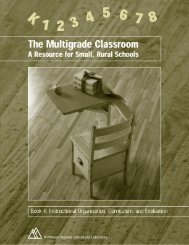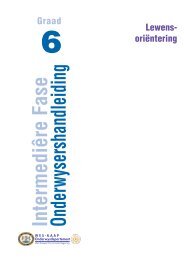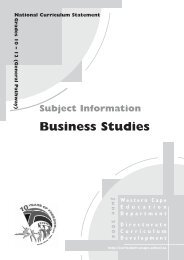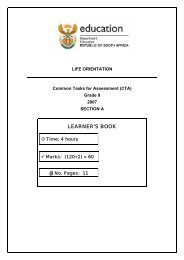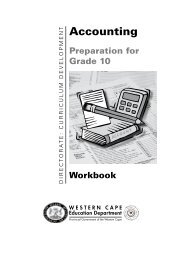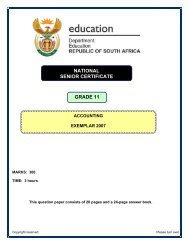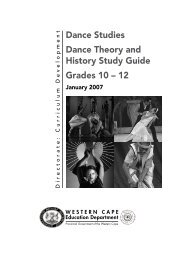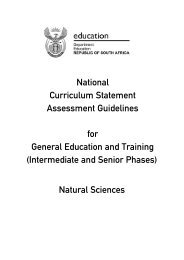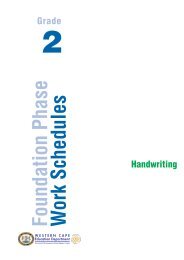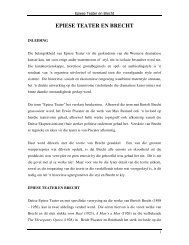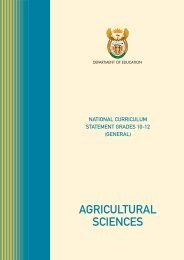FINAL Memo - History P1 - Exemplar 2007.pdf - Curriculum ...
FINAL Memo - History P1 - Exemplar 2007.pdf - Curriculum ...
FINAL Memo - History P1 - Exemplar 2007.pdf - Curriculum ...
Create successful ePaper yourself
Turn your PDF publications into a flip-book with our unique Google optimized e-Paper software.
NATIONALSENIOR CERTIFICATEGRADE 11HISTORY <strong>P1</strong>EXEMPLAR 2007MARKING GUIDELINEThis memorandum consists of 15 pages.Copyright reservedPlease turn over
<strong>History</strong>/<strong>P1</strong> 2DoE/<strong>Exemplar</strong> 2007NSCMEMORANDUM1. SOURCE-BASED QUESTIONSMARKING SOURCE-BASED QUESTIONS• In marking all source-based questions credit needs to be given to any othervalid and relevant viewpoints, arguments, evidence or examples.• In the allocation of marks emphasis should be placed on addressing therequirements of the question.• In these marking guidelines the requirements of the question (skills thatneed to be addressed) as well as the level of the question are indicated initalics.LEVELS OF SOURCE-BASED QUESTIONSLEVEL 1 (L 1)LEVEL 2 (L 2)LEVEL 3 (L 3)• Extract relevant information and data from thesources• Organise information logically• Explain historical concepts• Categorise appropriate or relevant source ofinformation provided to answer the questions raised• Analyse the information and data gathered from avariety of sources• Evaluate the sources of information provided toassess the appropriateness of the sources for thetask• Use historical concepts to structure information abouta period or issue• Analyse the socio-economic and political powerrelations operating in societies• Explain the various interpretations and perspectivesof historical events and why people in a particularhistorical context acted as they did• Handle and draw conclusions from quantitative dataCopyright reservedPlease turn over
<strong>History</strong>/<strong>P1</strong> 3DoE/<strong>Exemplar</strong> 2007NSCMEMORANDUM2. EXTENDED WRITING• MARKERS MUST BE AWARE THAT THE CONTENT OF THEANSWER WILL BE GUIDED BY THE TEXTBOOKS IN USE AT THEPARTICULAR CENTRE• CANDIDATES MAY HAVE ANY OTHER RELEVANTINTRODUCTION AND OR CONCLUSION THAN THOSEINCLUDED IN A SPECIFIC ESSAY MARKING GUIDELINES• IN ASSESSING THE OPEN ENDED SOURCE-BASED QUESTIONSCANDIDATES SHOULD BE GIVEN CREDIT FOR ANY OTHERRELEVANT RESPONSEGlobal assessment of essaysThe essays will be assessed holistically (globally). This approach requires the educator toscore the overall product as a whole, without scoring the component parts separately. Thisapproach encourages the learner to offer an individual opinion through using selectedfactual evidence to support an argument .The learner will not be required to simplyregurgitate "facts" in order to achieve a high mark. It will also discourage learners to prepare"model" answers and reproduce them without taking into account the specific requirementsof the question. Holistic essay marking credits learners' opinions. Holistic assessment, unlikecontent based marking, does not penalise language inadequacies as the emphasis is on thefollowing:• the construction of argument;• the appropriate selection of factual evidence to support such argument; and• the learner's interpretation of the question.Assessment procedures of an essay1. Keep the synopsis in mind when assessing the essay.2. During the first reading of the essay ticks need to be awarded for a relevantintroduction (indicated by a bullet in marking guideline/ memorandum) each of the mainpoints/aspects that is properly contextualised (also indicated by bullets in marking guideline/memorandum) and a relevant conclusion (indicated by a bullet in marking guideline/memorandum) e.g. in an answer where there are 5 main points there will be 7 ticks.Copyright reservedPlease turn over
<strong>History</strong>/<strong>P1</strong> 4DoE/<strong>Exemplar</strong> 2007NSCMEMORANDUM3. The following additional symbols can also be used:• introduction, main aspects and conclusion not properlycontextualised• wrong statement• irrelevant statement ||||• repetition R• analysis A√• interpretation 1√4. The first reading of an essay will also be to determine to what extent the main aspectshave been covered and to allocate the content level (on the matrix).C LEVEL 35. The second reading of an essay will relate to the level (on the matrix) of presentation.C LEVEL 3P LEVEL 16. Allocate an overall symbol and mark with the use of the matrix.C LEVEL 3 B+P LEVEL 1 39The matrixThe criteria according to which the essay will be assessed are organised within a matrix andthe matrix will be used to allocate a symbol to an essay. Both the content and presentationaxes are divided into eight competency levels. Each with criteria that will be used to assessan essay. (See below)Copyright reservedPlease turn over
<strong>History</strong>/<strong>P1</strong> 5DoE/<strong>Exemplar</strong> 2007NSCMEMORANDUMGrade 11 extended writing matrixPRESENTATIONCONTENTLEVEL 7Very wellplanned andstructured.Goodsynthesis ofinformationConstructed anargumentVery good useof evidence tosupport theargumentLEVEL 6Well plannedand structuredSynthesis ofinformationConstructed anargumentEvidence usedto support theargumentLEVEL 5Writingstructured.Constructed anargumentEvidence usedto supportargumentLEVEL 4Clear attemptto construct anargumentEvidence usedto a largeextent tosupport theargumentLEVEL 3Some attemptto organise theinformationinto anargumentEvidence notwell used insupporting theargument.LEVEL 2Largelydescriptive/with little someattempt todevelop anargument.LEVEL 1Answer not atall wellstructured.LEVEL 7Question hasbeen fullyanswered.Contentselection fullyrelevant to line ofargument.LEVEL 6Question hasbeen answered.Contentselectionrelevant to a lineof argument.LEVEL 5Questionanswered to agreat extent.Contentadequatelycovered andrelevant.LEVEL 4Questionrecognisable inanswer.Some omissions/irrelevantcontentselection.LEVEL 3Contentselection doesnot alwaysrelate.Omissions incoverage.LEVEL 2Sparse content.QuestioninadequatelyaddressedLEVEL 1Question notanswered.Inadequatecontent.Significantirrelevance27-30 24-2624-26 23 21-2221-22 20 18-1918-19 17 15-1615-16 14 12-1312-13 11 9-109-10 0-8Copyright reservedPlease turn over
<strong>History</strong>/<strong>P1</strong> 6DoE/<strong>Exemplar</strong> 2007NSCMEMORANDUMQUESTION 1: WHAT CHALLENGES DID LENIN ENCOUNTER IN THEESTABLISHMENT OF A COMMUNIST STATE?1.1.1 [Definition of concept using Sources 1A and 1B – L1 – LO1; (AS1); LO2 (AS1); LO3(AS3)]A policy introduced by Lenin which had the following characteristics:• Private ownership was prohibited• Government took control of the economy• Industries, mines, banks and the railways were nationalized• People were employed according to the needs of industry and theeconomy• Any other relevant response (any 2 x 2) (4)1.1.2 [Definition of concept using Sources 1A and 1B – L1 – LO1; (AS1); LO2 (AS1); LO3(AS3)]• Was a compromise between capitalism and communism• In order to encourage food production, peasants were allowed to selltheir crops in the markets only if they produced their quota• Productivity increased• Poverty reduced• Any other relevant response (any 2 x 2) (4)1.2 [Interpretation of evidence in Source 1B – L3 – LO3; AS3]War Communism• Government took control of the economy.• Private trading was banned• Profit making was decreed to be exploitation.• Factories with more than ten workers were taken over by thegovernment and strict discipline was imposed in them.• Strikes were illegal, etc (2 x 2) (4)New Economic Policy• The ending of requisitions from the peasants.• Private enterprise was allowed in trade and small-scale industry.• Compulsory labour ceased• The labour armies were disbanded• Bonuses were introduced for extra work.• The Currency was put back on a sound footing and a regular systemof taxation was introduced.• Large-scale industry (coal, iron, steel, oil, electricity, railways) was toremain in the hands of the State. (2 x 2) (4)1.3 [Interpretation of evidence in Sources 1A and 1C – L3 – LO3; AS3]• The surplus crops they grew were taken by the government to feedthe factory workers and the army. The peasants resented this.• Peasants refused to hand over the food, or failed to plant crops thatthey knew would be taken.• Many people did not receive enough rations to live on.• The situation in the factories was just as chaotic with managers fleeingCopyright reservedPlease turn over
<strong>History</strong>/<strong>P1</strong> 7DoE/<strong>Exemplar</strong> 2007NSCMEMORANDUMabroad and workers refusing to work for starvation wages.• By 1921, famine had broken out.• Industrial production was down to one seventh of the 1913 level.• It is estimated that 3.5 million people died from typhoid alone.• With the economy in ruins; inflation out of control; and the countryin the grip of famine; the peasants called for the overthrow ofCommunism.• Any other relevant response (any 2 x 2) (4)1.4 [Interpretation of evidence from Sources 1A, 1B, and 1C– L3 – LO1; AS2]• The result of this War Communism was chaos• Peasants resented the policy• the revolt of the sailors of the Baltic Fleet at the Kronstadt naval base• Any other relevant response (3 x 1) (3)1.5.1 [Interpretation of evidence from Source 1E– L3 – LO1; AS3]• They saw the NEP as a return to capitalism• They did not like the idea that 'making a profit' was the main drivingforce for smaller industries.• They disliked the fact that the bosses of factories or kulaks(rich peasants) could hire men to work for them• ‘Nepmen’ made high profits by buying food and goods cheaply andselling them more dearly (any 3 x 1) (3)1.5.2 [Interpretation of evidence from Source 1E– L3 – LO1; AS3]• They made the goods appear in the shops in quantities that hadnot been seen for years.• Nepmen also set up restaurants and made enormous amounts ofmoney from dealing in property and gambling.• The majority realised that these measures were needed to reviveindustry and get more food produced (3 x 1) (3)1.6 [Interpretation of evidence from Source 1E– L3 – LO1; AS2]• The Kronstadt rising forced the people of Russia to take stock ofWar Communism• The ideals for which they fought had now being taken away• Any other relevant response (2 x 2) (4)1.7 [Interpretation of evidence from Source 1D – L3 – LO3; AS1/3]• These sailors had played vital roles in both the November Revolutionand the Civil War• They demanded new elections for the Soviets,• freedom of speech for other left-wing parties, freedom for trade unions,• the release of left-wing political prisoners,• the end of food requisitions and barrier searches,• the right of peasants to hold land, and freedom of production forcraftsmen• Any other relevant response (any 3 x 2) (6)Copyright reservedPlease turn over
<strong>History</strong>/<strong>P1</strong> 8DoE/<strong>Exemplar</strong> 2007NSCMEMORANDUM1.8 [Interpretation of evidence - L2 – LO3; AS2]Candidates need to chose either War Communism or the NEP andsubstantiate the response• War Communism - temporary measure to restore the economy ofRussia; The Red Army was supplied with weapons and food which itneeded to fight the war• NEP - War Communism failed; restored the conditions in Russia• Any other relevant response (6)1.9 EXTENDED WRITING1.9.1 [Analysis, synthesis and the ability to construct a coherentargument based on evidence – L3 – LO2 (AS2&3); LO3; (AS2,3 &4)]Candidates should include the following aspects in their response:SYNOPSISCandidates should evaluate the policies of War Communism and theNEP. In evaluating these policies the candidates must give examplesof the successes and failures of each policy.MAIN ASPECTS• Introduction: Candidates should focus on reasons for the introductionof each policy.ELABORATION• War Communism - economic chaos after First World War; Need tobring the economy under state control; government took control ofthe economy. Private trading was banned and profit making wasdecreed to be exploitation. Factories with more than ten workerswere taken over by the government and strict discipline was imposedin them. Strikes were illegal, etc• Failures of the War Communism• NEP - The ending of requisitions from the peasants. Private enterprisewas allowed in trade and small-scale industry. Compulsory labourceased; the labour armies were disbanded and bonuses wereIntroduced for extra work. The Currency was put back on a soundfooting and a regular system of taxation was introduced.Large-scale industry (coal, iron, steel, oil,electricity, railways) was to remain in the hands of the State.• Successes and failures of the NEP• Conclusion: Candidates should tie up their essay. (30)Use the matrix on page 5 in this document to assess this essayCopyright reservedPlease turn over
<strong>History</strong>/<strong>P1</strong> 9DoE/<strong>Exemplar</strong> 2007NSCMEMORANDUM1.9.2 [Analysis, synthesis and the ability to construct a coherentargument based on evidence – L3 – LO2 (AS2&3); LO3; (AS2,3 &4)]The candidate should include the following points in their responses.SYNOPSISCandidates should explain how a peasant, a member of the Communist Partyand an industrial worker would have responded to the policies of WarCommunism and NEP.MAIN ASPECTS• Introduction: Candidates should focus on why the Great Depressionof 1929 started in the USA.PeasantMember of theCommunist PartyIndustrial workerWAR COMMUNISMRejected becauseprivate ownershipprohibitedAccepted – supportedthe principles of thepartyAccepted becausepolicies favoured theworking class (nonexploitation)Rejected – someworkers felt that wereexploited by the stateNEPAccepted – Rich peasants -because allowed to selltheir produce; incentivesofferedRejected - compromise;divided the partyAccepted because theywere given wage incentivesRejected – exploitation ofworkers• Conclusion: Candidates who support their argument with relevantexamples/reasons should be given credit.Use the matrix on page 5 in this document to assess this essay(30)[75]Copyright reservedPlease turn over
<strong>History</strong>/<strong>P1</strong> 10DoE/<strong>Exemplar</strong> 2007NSCMEMORANDUMQUESTION 2: WHAT IMPACT DID THE GREAT DEPRESSION OF 1929 HAVE ONTHE UNITED STATES OF AMERICA?2.1.1 (a) ([Definition of concept using Sources 1A and 1B – L1 – LO1; (AS1); LO2 (AS1);LO3 (AS3)]• Government left people alone to get on with their own affairs• Non-interference by the government• Freedom of initiative and enterprise• Any other relevant response (any 2 x 2) (4)(b) [Definition of concept using Sources 1A and 1B – L1 – LO1; (AS1); LO2 (AS1);LO3 (AS3)]• Period when the Americans:• Enjoyed prosperity• Poverty would cease• There would be 'a chicken in every pot and two cars in everygarage'• Any other relevant response (any 2 x 2) (4)2.1.2 [Interpretation of evidence – L3 – LO1; AS3]• To win the support of the people• To restore the confidence in the American people• Any other relevant response (any 1 x 2) (2)2.1.3 [Analysef evidence – L3 – LO1; AS3]• The government left people alone to get on with their own affairs• Laissez-faire attitude of the government• Rugged individualism• Any other relevant response (3 x 1) (3)2.1.4 [Interpretation of evidence – L3 – LO3; AS3]• Land of opportunity• Resources and industry• Freedom of initiative and enterprise• Self-government• Freedom of the individual• Policy of non-interference (any 4 x 1) (4)2.1.5 [Interpretation of evidence – L3 – LO2; AS2]• Confidence in the government• Allegiance to the government• Any other relevant response (2 x 2) (4)2.1.6 (a) [Evaluation of evidence from Source 2A – L3 – LO3; AS2/3]• Supported - non-interference- freedom of initiative and enterprise (2 x 2) (4)Copyright reservedPlease turn over
<strong>History</strong>/<strong>P1</strong> 11DoE/<strong>Exemplar</strong> 2007NSCMEMORANDUM(b) [Evaluation of evidence from Source 2A – L3 – LO3; AS2/3]• Prosperity• Non-interference of government• Equal opportunity and freedom to the individuals (2 x 2) (4)2.2.1 [Analysis of evidence from Sources 2A and 2B – L3 – LO1; AS3]• People were poor• People experienced bankruptcy• Any other relevant response (1 x 3) (3)2.2.2 [Evaluation of evidence from Sources 2A and 2B – L3 – LO1; AS4]• Confused - Source 2A - speaks about prosperity whereasSource 2B reflects poverty• Lost confidence in the government (any 1 x 2) (2)2.2.3 [Interpretation of evidence – L3 – LO3; AS1&2]• Cannot be supported - reflects the reality of the situation in theUSA in the 1930s - poverty as against prosperity (1 x 3) (3)2.3.1 [Comparison of evidence from sources – L2 – LO1; AS2]Within a space of one year - 1928-1929• The USA drifted into bankruptcy• The socio-economic situation of people changed (2 x 2) (4)2.3.2 [Comparison of evidence from sources – L2 – LO1; AS2]• Laissez-faire attitude of the government• Non-interference of the government• Lack of a proper leader• No vision• Lack of monitoring mechanism (2 x 2) (4)2.4 EXTENDED WRITING2.4.1 [Analysis, synthesis and the ability to construct a coherentargument based on evidence – L3 – LO2 (AS2&3); LO3; (AS2,3 &4)]Candidates should include the following aspects in their response:SYNOPSISCandidates should discuss the causes and effects of the Great Depressionof 1929 on the USA.MAIN ASPECTS• Introduction: Candidates should focus on why the Great Depressionof 1929 started in the USA.Copyright reservedPlease turn over
<strong>History</strong>/<strong>P1</strong> 12DoE/<strong>Exemplar</strong> 2007NSCMEMORANDUMELABORATION• Causes - Panic sales on stock market caused shares to become mostvalueless thus making millions bankrupt; policy of isolation - tradesuffered; high import tariffs were imposed; the policy of free enterprise;use of credit buying system of hire purchase; farmers unable to repaytheir loans• Effects - Disappointment; discontentment; despair; millions wereunemployed; money was devalued; prices of consumer goods rosedrastically; banks closed; bankruptcy; industries, factories andcompanies began to fold up; poverty occurred on a wide scale;socio-economic problems such as crime and juvenile delinquencybecame rife• Any other relevant point• Conclusion: Candidates should tie up their argument by showing theimpact of the Great Depression of 1929 on the USA. (30)Use the matrix on page 5 in this document to assess this essay2.4.2 [Analysis, synthesis and the ability to construct a coherentargument based on evidence – L3 – LO2 (AS2&3); LO3; (AS2,3 &4)]The candidate should include the following points in their response.SYNOPSISCandidates should evaluate the statement and show how they intendsupporting their argument with relevant evidence.MAIN ASPECTS• Introduction: Candidates should take a specific line of argument and showhow they intend supporting it.ELABORATION• Hoover followed a policy of non-interference• People were left to conduct their own affairs - 'rugged individualism'• The land of opportunity – practice of capitalism• Principles of self government, liberty, equal opportunity and freedom to theindividual• Convinced that prosperity would increase• There would be 'a chicken in every pot and two cars in every garage'• Any other relevant point• Conclusion: Candidates should tie up their argument.Use the matrix on page 5 in this document to assess this essay(30)[75]Copyright reservedPlease turn over
<strong>History</strong>/<strong>P1</strong> 13DoE/<strong>Exemplar</strong> 2007NSCMEMORANDUMQUESTION 3: WHAT INFLUENCE DID AFRICAN AND AFRIKANERNATIONALISMS HAVE ON SOUTH AFRICAN POLITICS IN THE1930s?3.1.1 [Extraction of evidence – L3 – LO1; AS2]• The struggle that was fought by great African leaders for freedom has now beenrealised.• Coka pays tribute to these leaders and claims that Africans havereached their destiny of freedom, liberty and opportunity (any 1 x 3) (3)3.1.2 [Extraction and organisation of evidence – L1 – 31; AS3]• These leaders suffered and died for the struggle to ensure therealisation of freedom• They contributed to the freedom of Africa ensuring that the principlesof liberty, equality, opportunity and justice were finally realised (2 x 3) (3)3.1.3 [Evaluation of evidence – L2 – LO1; AS4]• No - it gives limited information on the reasons for the rise ofAfrican nationalism.• Other sources of information are needed to make a comprehensivestudy of the period (any 1 x 2) (2)3.1.4 [Interpretation of evidence – L3 – LO3; AS3]• A gender activist would be unhappy and perturbed about Coka'scomments because he only focuses on the role men played in thestruggle for freedom.• The women who sacrificed their lives for the struggle are notacknowledged by Coka• He is not gender sensitive because he gives a one side viewof the struggle (2 x 2) (4)3.2.1 [Interpretation of information from source – L2 – LO3; AS1]Candidates may say Yes - justified• Africa was colonised and stripped of her wealth therefore the desire to reclaimAfrica• Africans wanted to restore their dignity and strove for independence andautonomy• They wanted to rule themselves and take control of their future and shapetheir own destinyCandidates may say No – Not justified• Africa needs the expertise and skills from other nations of the world andtherefore cannot survive and functions on its own• Africa cannot survive as an island it needs inter - regional/continentalco-operation to sustain its economic growth (any 2 x 2) (4)3.2.2 [Comparison of evidence from sources – L2 – LO2; AS2]• Source 3B outlines the reasons for the rise of African nationalism whileSource 3A states how various African leaders suffered and died againstCopyright reservedPlease turn over
<strong>History</strong>/<strong>P1</strong> 14DoE/<strong>Exemplar</strong> 2007NSCMEMORANDUMoppressive regimes to ensure that Africans could attain their freedom (2 x 2) (4)3.2.3 [Interpretation of evidence to reach a conclusion – L2 – LO3; AS2/3]• All three countries fought against colonial rule• These countries united behind their national leaders and fought for theirfreedom and independence (2 x 2) (4)3.3 [Definition of concept using Sources 1A and 1B – L1 – LO1; (AS1); LO2 (AS1); LO3(AS3)]• Africans desired unity and wanted to be ruled by Africans• End to colonial rule and assert African dominance• To be ruled by Africans and attain their freedom (economic, politicaland social) (2 x 2) (4)3.4.1 [Extraction of evidence – L1 – LO1; AS2]• Supported the rise of Afrikaner nationalism• Gave rise to a new found patriotism among the Afrikaners (any 1 x 2) (2)3.4.2 [Interpretation of evidence - L2 – LO1; AS3]• Ox - wagons symbolised the trek of the Afrikaners from the Cape into thehinterland of South Africa• Ox - wagon symbolised the hardship endured by the Afrikaners during thetrek• Ox - wagons also served as an important mode of transport,accommodation and was an integral part of the Afrikaners life (any 2 x 2) (4)3.4.3 [Interpretation of evidence – L1 – LO1; AS3]• It depicts the Battle of Blood River• The defeat of the Zulu army by the Afrikaners in the battle• The centenary celebration of the battle• Any other relevant response (any 2 x 2) (4)3.5. [Comparing evidence in Sources 4A and 4B – L2 – LO2; AS3 ]• Yes - Both Africans and Afrikaners had the desire to be united underone nationhood• Ruled by people who have the same language, religious, value andcultural systems• Wanted to celebrate their 'nationhood and freedom'• Any other relevant point (2 x 2) (4)3.6 EXTENDED WRITINGCopyright reserved3.6.1 [Analysis, synthesis and the ability to construct a coherentargument based on evidence – L3 – LO2 (AS2&3); LO3; (AS2,3 &4)]Candidates should include the following aspects in their response:SYNOPSISCandidates should outline the various reasons as to why black SouthAfricans had to ensure that they assert themselves and reclaimwhat was theirs (nationhood, identity, land etc).Please turn over
<strong>History</strong>/<strong>P1</strong> 15DoE/<strong>Exemplar</strong> 2007NSCMEMORANDUMMAIN ASPECTSIntroduction: Candidates should indicate why it was important forAfricans to reclaim their identity.ELABORATION• The process of colonialism and imperialism• The impact of colonialism on African communities• Challenges facing Africans under colonial rule• Growth of nationalism and the desire for independence/freedom• Impact of the ANC and ANCYL on Africans• Quest for freedom, equality, justice• The influence of the concept 'Africa for Africans'• Any other relevant point• Conclusion: Candidates should tie up their argument with a relevantconclusion, demonstrating the significance of the re-awakening Africannationalism among black South Africans (30)3.6.2 [Analysis, synthesis and the ability to construct a coherentargument based on evidence – L3 – LO2 (AS2&3); LO3; (AS2,3 &4)]The candidate should include the following points in their response.SYNOPSISCandidates should discuss the various reasons that led to the rise of AfrikanerNationalism.MAIN ASPECTSIntroduction: Candidates should indicate why Afrikaners decided to consolidatetheir national identity in the 1930s.ELABORATION• Impact of the 1929 Great Depression• Unemployment rose – leading to poor white problem• Rise in poverty amongst rural and urban Afrikaners• Massive urbanisation of blacks – competition for jobs• Role of D.F.Malan and the Purified National Party• Impact of the Broderbond and Federation of Afrikaans Cultural Organisations• Centenary celebration of the Great Trek• Build up to the festivities of 1938• Any other relevant point (30)[75]Use the matrix on page 5 in this document to assess this essayCopyright reservedPlease turn over
<strong>History</strong>/<strong>P1</strong> 16DoE/<strong>Exemplar</strong> 2007NSCMEMORANDUMCopyright reserved



